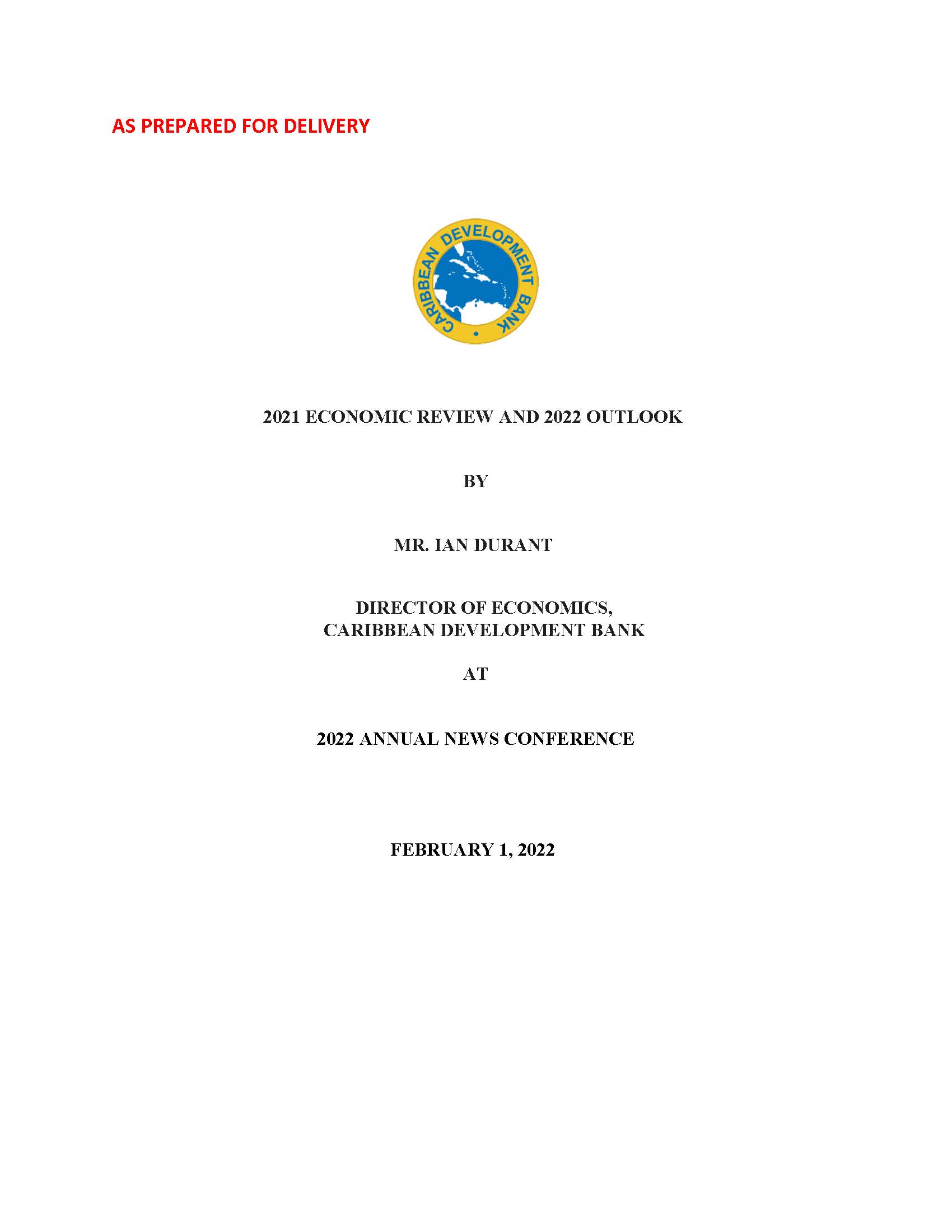2022 Annual News Conference - Mr. Ian Durant

Good morning to those present physically and to those joining us online.
My intention this morning is to outline the broad development context and priorities by examining the economic performance of the region; the immediate prospects; and more importantly, the policy imperatives for limiting the impact of the economic shocks that are frequently encountered by the Region.
Despite being a challenging year for the region, 2021 witnessed the continuation of a nascent regional recovery that began in the latter part of 2020.
The combination of easing of border controls and internal lockdown measures and the continued implementation of fiscal stimulus programs in some BMCs helped regional economies in recovering some of the lost ground in economic activity.
In 2021, CDB’s Borrowing Member Countries are estimated to have grown by 3%, with commodity-exporting economies growing by 2.7% and service-exporting economies expanding by 3.2%.
Growth in service-exporting economies reflected an almost 10% increase in tourist arrivals between January and September 2021 relative to the same period in 2020, much of which was recorded during the latter part of the period, as many Caribbean countries benefited from a recovery in international leisure travel.
This uptick in travel was partly enabled by the introduction of protocols for the safe resumption of international travel; robust vaccination take-up in source markets; and pent-up demand for the Region’s tourism products.
Despite the significant resurgence in regional tourism, arrival numbers for the January to September period were still 65% below those of the same period in 2019.
Although most of the service-exporting economies benefitted from an increase in tourist arrivals, some of these countries maintained tight travel restrictions for most of the year that reduced arrivals. Of these, the Cayman Islands and Grenada managed to record positive GDP growth despite the fall in arrivals, while GDP fell marginally in St. Kitts and Nevis. The impact of the pandemic on tourism in St. Vincent and the Grenadines was exacerbated by the volcanic eruption during the first half of the year, leading to a contraction in that economy.
Among commodity-exporting countries, the average growth rate of 2.7% was driven by Guyana, which recorded growth of 19.9%. This performance reflected increased production in the expanding crude oil industry, with the non-oil segment of the economy growing by 4.6%. Conversely, GDP declined in Suriname and Trinidad and Tobago. In Suriname, fiscal consolidation and exchange rate depreciation reduced domestic purchasing power, and together with protracted lockdowns and curfews, caused the contraction in GDP. Similarly, GDP in Trinidad and Tobago fell because of lower natural gas production and its transmission to downstream industries; as well as the impact of mandated closures of service-sector entities.
The impact of the pandemic has had severe implications for fiscal performance and debt. The immediate response required governments to increase expenditures to protect lives and livelihoods and support social stability and cohesion. At the same time, revenues were negatively impacted by the contraction in economic activity. This combination of factors resulted in larger public sector deficits and increased indebtedness. Consequently, the average central government debt-to-GDP ratio in CDB’s BMCs increased by 17.7 percentage points in 2020 after falling slightly in 2019.
However, the debt ratio declined by around 2 percentage points in 2021 to 80.5%. This reflected the improved GDP growth performance together with the containment of expenditures as countries attempted to maintain some focus on debt sustainability while grappling with the fiscal challenges associated with the pandemic.
The debt management efforts in Haiti and St. Vincent and the Grenadines were compounded by natural hazard events.
Prospects for Regional growth in 2022 are favourable, with growth projected to increase to approximately 9.1%. The projected outturn is dominated by Guyana, which is expected to grow by 47.5% as output in the oil and gas sector continues to build momentum. Among the other commodity exporters, a resurgence in energy production is anticipated to alleviate supply-side constraints and lead to an increase in GDP in Trinidad and Tobago; while the gradual easing of restrictions to movement and increased capital expenditure are forecasted to cause a turnaround in economic performance in Suriname.
Service-exporting economies are forecasted to gain momentum, growing at an average rate of 4.8%, reflecting the continued recovery of the tourism sector. However, sustaining the growth of tourist arrivals will depend on increasing vaccination rates, effective management of the pandemic without resorting to full and lengthy lockdowns; and continued confidence of source markets in the protocols established for safe travel to the region.
The outlook for growth is also underpinned by expectations of accelerated implementation of some large infrastructure projects across the region.
A key lesson from the impacts of the pandemic is that those countries entering the pandemic on a strong macro-fiscal footing fared better in weathering the headwinds.
As such, countries are redoubling efforts to achieve debt sustainability despite the extant challenges. Many countries are implementing programmes to achieve sustainability with support from the international financial institution community, including from CDB. Others are doing so outside of supported programmes but have established explicit fiscal anchors to function as platforms for macroeconomic policy frameworks.
BMCs have taken steps to contain expenditure, optimize revenue collection, minimize interest cost by accessing concessional sources of finance and, in some cases, have restructured or are restructuring debt. Consequently, CDB is projecting a continued decline in debt ratios as BMCs target the internationally accepted threshold of 60%.
The outlook is subject to a number of downside risks that could lower growth prospects and affect the fiscal outturns. These include the emergence of new COVID variants that result in spikes in infection, illness, hospitalizations and death; inflationary pressures caused by supply chain disruptions that reduce purchasing power and global demand; heightened geopolitical tensions; rising interest rates; and natural hazard events.
The impact of the pandemic exposed the structural weaknesses that have resulted in the Region’s acute vulnerability to global economic shocks. The impact of the pandemic caused socio-economic dislocation in all countries across the globe, but there is no doubt that the high export concentration, especially in tourism, that results from the structural weaknesses affecting the Region made the economic impact far deeper.
What is clear is that the rescue and recovery efforts must be consistent with the longer-term repositioning of the Region’s economies that is necessary to reduce these vulnerabilities. The region must become more resilient in all of its development dimensions – social, production, financial, environmental and institutional - but I want to focus on addressing production resilience.
Of course, there is a symbiotic relationship among these dimensions of development, but production resilience speaks to the ability of the economy to withstand and recover from shocks, and relies critically on diversified exports in small economies such as our BMCs.
At present, exports in the region are largely driven by countries’ natural endowments – whether tourism assets or mineral deposits – largely because of the lack of competitiveness of the economies. This has led to a situation where the largest export product accounts for more than half of total exports in many countries and this creates an acute vulnerability.
So what are the imperatives for repositioning the economies to achieve diversification of their exports?
Well, the overarching need is to create more innovative and competitive economies.
I will identify a few imperatives in this regard.
Firstly, we have to make public sector regulatory processes more efficient, accessible and easier to navigate by improving the underlying business processes and utilizing digitalization. Time-consuming regulatory processes increase production costs and lower labour productivity, making it difficult for domestic producers to compete globally on price.
Secondly, we need to prioritize the development of sustainable energy options. This would have the effect of stabilizing or reducing energy costs and promoting energy security.
Thirdly, the region needs to upgrade logistics quality. This includes improving road networks, ports, storage facilities, trade-related processes and connectivity. This makes it less costly to exchange goods, services and ideas.
Fourthly, education needs to be modernized so that we prepare students for the future of work, teaching them for digitalization and through digitalization.
Fifthly, the region’s economies must exploit the full potential of the larger protected CARICOM Single Market and Economy. This requires, in addition to the foregoing, cooperating and synchronizing standards, procedures, processes and infrastructure to facilitate intra-regional trade and the development of regional supply chains.
A common theme running through all the imperatives is digitalization; and fully exploiting digitalization is key to driving innovative and competitive economies.
In summary, 2021 marked the continuation of the Regional recovery, and we expect this to continue into 2022.
However, as we rebuild, we must focus on building back better to reposition the Region for greater resilience, including production resilience.
The impact of COVID-19 has shown us that it cannot be business as usual.
Instead, it should be business unusual as we seek to move our nations into new export sectors that can drive us towards sustainable development.
This policy agenda is urgent, and the future is now.
I now turn you over to our Director of Projects, Mr. Daniel Best, to update you on the ways that CDB has been supporting countries in increasing resilience.
Thank you.




